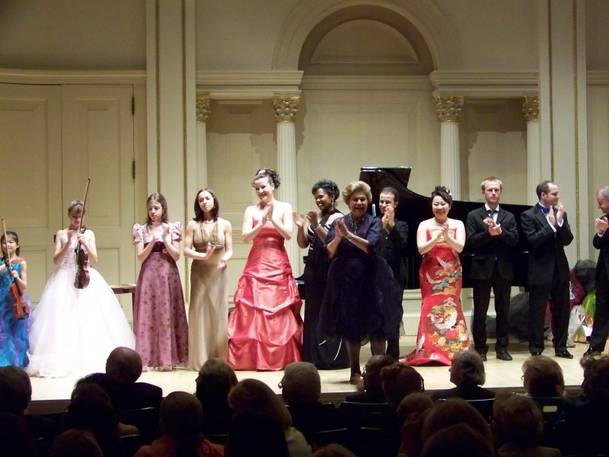


The IBLA concert at Carnegie Hall last Tuesday was a testament to the unifying power of music. The evening’s performers were the finalists of a classical music competition held in Ragusa Ibla, Sicily [2] this summer, and they traveled internationally to attend. Violinists, pianists, sopranos, and other instrumentalists of different ages showcased their talents in a remarkable event that proved that classical music is anything but dead.
What was perhaps most encouraging, and always astounding for those who keenly observe the state of classical music today, was the precociousness of some of the players. Twelve-year-old pianist Vladana Perovic from Montenegro interpreted a Berkovich piece with a maturity and intelligence well beyond her age. The pale and lanky girl, of seemingly shy disposition, engaged the piano in a manner that suggested her understanding of the score along with a technical mastery of it. The same could be said of Elena Kawazu from Japan, an even younger girl, whose impressive, technically advanced Wieniawski was made even more so by the physical and expressive power of her playing. Another violinist, young American Esther Muradov, clad in a deceivingly child-like, pink ballerina dress, produced texturally rich music, full of the languor and poignancy of the violin at its best.
This is not to say that the adult musicians were any less brilliant. Norwegian pianist Kristian Lindberg, 
In honor of Sicily, turn-of-the-century composer Pietro Floridia was a local, if unexpected, name on the program. Moltisanti has sought to bring attention to Floridia’s legacy, tirelessly promoting the music he feels has been largely neglected or forgotten by the annals of history. The gems that evening included two romantically unbridled pieces, interpreted to great effect by Milksch and Iwamoto-Ruiter. Among the audience were Floridia’s American granddaughter and great-granddaughter, present to hear the seldom performed, re-discovered works.
In a concert where a listener may not know what to expect from budding professional musicians, the public inside Carnegie Hall seemed impressed, stirred even, by the quality of the music. Whispered comments between audience members became increasingly congratulatory as each piece closed and it was an event that the performers themselves must have taken great pride in. The way in which they were dressed, the women and girls especially—Iwamoto-Ruiter went so far as to switch outfits from one song to the next, while Italian soprano Simona Rodano took up the stage with a glitzy, operatic ball gown—implied that perhaps this would be their only chance at exhibition. Baroness Mariuccia Zerilli-Marimò [5], Chairwoman of IBLA in New York, would certainly disagree. She called the talent "phenomenal", a "United Nations of music". With regard to the younger players, she added that despite the intensity of their work, they were happy, ordinary children. If their playing continues at such extraordinary levels, there's no doubt they'll play Carnegie again.
Source URL: http://440468.6bgr9ubv.asia/magazine/focus/art-culture/article/ibla-grand-prize-how-do-you-get-carnegie-hall-through-sicily
Links
[1] http://440468.6bgr9ubv.asia/files/10025721210036310jpg
[2] http://en.wikipedia.org/wiki/Ragusa,_Italy
[3] http://www.ibla.org/drbiousa.php4
[4] http://en.wikipedia.org/wiki/IBLA_International_Competition
[5] http://www.nyu.edu/pages/casaitaliana/history.html
[6] http://www.ibla.org/